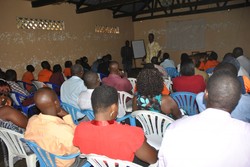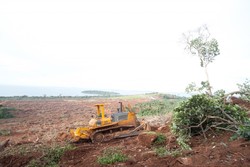NAPE blog | July 30, 2012
Communal land associations: A perfect solution to land grabbing
By David Kureeba
Land grabbing in the eyes of government and investors does not exist. According to investors some of them get this land through or from government, so it is government business to identify land with or without occupants and locate it to them. To investors tenure in Uganda doesn’t seem to matter whether it’s customary land or public land used by communities. As long as they are guaranteed government backing, they go ahead to use the land. Land grabbing, doesn’t only refer to forceful eviction of people from their land; it also occurs when land previously used by local communities is leased or sold to foreign and local investors, including corporations and governments. Typically, the land is taken over for growing crops to sell on the overseas market, and or agro-fuels or trees.
Many reasons explain land grabbing. According to communities NAPE has been working with, for example, in Kalangala District, government realized that Kalangala was largely a fish folk community. A big part of people’s income was from fishing. Oil palm growing was introduced as an alternative to fishing. However, when oil palm was introduced fish reduced. This was attributed to application of agro-chemicals in the oil palm plantations which found their way into the lake. Meanwhile, communities used to do farming alongside fishing.
Communities were given agro-inputs and initial payment to enable them clear their land and other protective gears like rain boots and wheel-barrows all in form of a loan. When time come to repaying the loan, fishermen failed to get the money and this accelerated the sale of the land to those who could manage oil palm. People ended up being displaced by oil palm due to failure to repay loans. This way their land was grabbed. Others lost land, which was originally communally-owned because they didn’t have any proof that the land was theirs, other than saying that they had been there all their lives and this is sometimes not very convincing to the courts of law. The courts here recognize land titles or customary certificates which is provided for in the laws of Uganda, but the question is: how many people know the procedure of registering to get a customary land certificate or title?
The answer is that it is the obligation of the government to educate people on how to live within the parameters of the law other than exploiting the ignorance of the people to grab land from them. Land grabbed from communities is converted into pine or eucalyptus tree plantations to benefit from carbon credits. The native forest is replaced by these species. In other regions like the Albertine rift land is grabbed for mining. Land conflicts and intertribal /ethnic clashes have occurred in some communities where land grabbing has occurred.
Rural urban migration has portrayed rural land to be idle. There are very few producers and many consumers. When the government looks at the so called “idle land” it gives it to investors to maximally ‘exhaust’ it. Remember most of the land in Uganda, which is about 80%, is customarily owned.

In most cases people leave their land and look for greener pastures eleswhere in cities and towns. By the time they return home to till the land, they find their territories in total disputes and wrangles. This also happens because sometimes they can without laying proper management of their property/estates. Even those who remain back home, they live on the land without documentation and proper management techniques regarding ownership, worse still, these people don’t form association that they can base on to defend their territorial lands.
In conclusion, communal land associations where people come together as a clan or as a group with a common goal, is the ultimate solution to land grabbing. With communal land associations communities will be having one voice and if anybody, be it government or investor, is interested in their land, that person is made aware of that the group is organized and therefore not easy to simply deploy graders to start tiling or clearing the land. These communal land associations once registered with their local leadership and local government, it gives communities a firm ground to protect, and themselves form of oppression legally with their mandate.
Land grabbing in Uganda is intensifying and spreading throughout the country. This development of industrial scale agriculture projects to supply global commodity markets is depriving local communities of access to natural resources, exacerbating rural poverty and aggravating a food crisis, and forests and biodiversity loss. Biodiversity is a need for everybody but not the greed and luxury for the rich.













